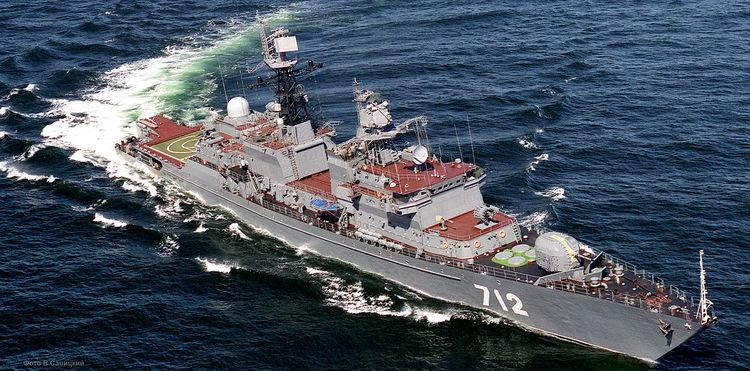Name Project 11540 Yastreb Succeeded by Admiral Gorshkov class | Preceded by Burevestnik class Planned 7 | |
 | ||
Builders Yantar yard , Kaliningrad Operators Soviet Navy, Russian Navy | ||
Neustrashimy-class frigates (Russian: Неустрашимый, alternate English spelling Neustrashimyy) are a series of large frigates in the Russian Navy. The Soviet designation is Project 11540 Yastreb ("Hawk"). Seven ships were planned for the class, but the fall of the Soviet Union disrupted those plans. Two ships were completed, both currently in active service.
Contents
Design and construction
The class was designed as a general purpose anti-submarine warfare (ASW) frigate to follow on from the Krivak-class frigates. This new class of frigates incorporates some stealth technology. The ship is equipped with a newly designed Zvezda-1 integrated sonar system (with NATO reporting name Ox Tail) as its primary ASW sensor.
The program started in 1986 and seven ships were originally planned. After the collapse of the Soviet Union the project was frozen and only one ship, Neustrashimy (Неустрашимый - "Dauntless"), was in active service with the Russian Baltic Fleet by the mid 1990s. On 24 February 2009 the second ship in the class, Yaroslav Mudry, left the Yantar shipyard in Russia's Kaliningrad for its first sea-trials. As of 2010, both Neustrashimyy and Yaroslav Mudry are operational with the Baltic Fleet.
The ships were built by Yantar Yard, Kaliningrad. Only Neustrashimy was completed by the time the Soviet Union collapsed. Two further ships were incomplete. Yaroslav Mudry (named after the great ruler of the Kievan Rus, Yaroslav the Wise) and Tuman ("Fog", named after a World War II era Soviet patrol boat whose crew exhibited great valour in combat with three German destroyers). As of 2009, the frigate Yaroslav Mudry has begun sea trials and entered service.
2008-09 deployment to Somalia
In late September 2008, Neustrashimy left the Baltic Fleet and was sent to the Gulf of Aden waters off the Somali coast to fight piracy in the region. Russian navy spokesman Captain Igor Dygalo told the Associated Press that the missile frigate Neustrashimy had left the Baltic Sea port of Baltiisk a day before the hijacking to cooperate with other unspecified countries in anti-piracy efforts. As of 27 October, the frigate was operating independently in the vicinity of a group of NATO warships near the Somali coast. On 11 November, Neutrashimy helped capture suspected pirates along with Royal Marines from HMS Cumberland; the suspected pirates had been attempting to board the merchant vessel MV Powerful. On 16 November 2008, the frigate prevented pirates from capturing Saudi Arabian ship MV Rabih.
Further deployment
In June 2016 Neustrashimyy was part of a maritime incident between Russian and United States navies in which the ship came in close proximity to USS Gravely in the Mediterranean, though both sides claim the other was at fault for the encounter. The American destroyer came within 315 yards (288 m) of the Russian vessel.
